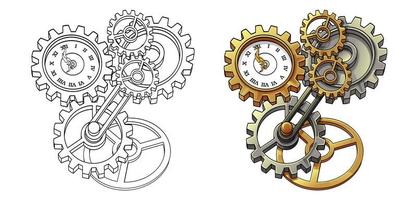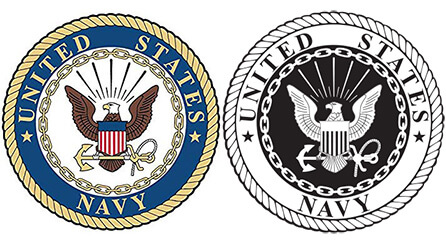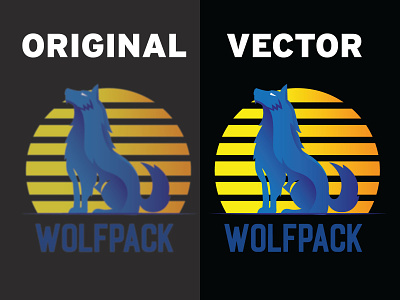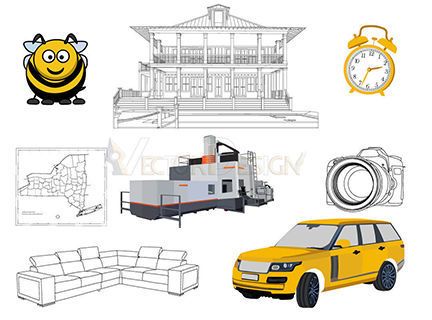Vector Conversion
Raster to Vector Conversion

Raster-to-vector conversion is a transformative process in the digital graphics domain, converting pixel-based raster images (commonly found in JPEG, PNG, or GIF formats) into scalable vector graphics defined by mathematical equations. Ideal for applications like printing and logo design, this conversion is crucial for precision and scalability. Vector graphics represented mathematically, offer infinite scalability without loss of quality, making them perfect for tasks like logo creation and illustration. Specialized software is used in the conversion process, tracing pixel-based images to create editable vector paths, allowing for easy modifications to shapes, colors, and other elements. Industries such as graphic design, advertising, and engineering widely employ raster-to-vector conversion to enhance the versatility of visual assets, streamlining workflows and contributing to seamless integration in various applications. As technology advances, the accuracy and efficiency of conversion tools continue to improve, reinforcing the importance of this process in the digital graphics landscape.
Image to Vector Conversion
Image-to-vector conversion is a transformative process in graphic design and digital imaging, converting pixel-based raster images (commonly found in formats like JPEG, PNG, or GIF) into scalable vector graphics. Overcoming limitations of scalability and precision in applications like logo design and printing, this conversion is crucial for tasks requiring infinite scalability without compromising quality. Specialized software uses algorithms to trace contours and details of raster images, creating scalable vector paths. The resulting graphics can be resized without losing clarity, making them suitable for diverse applications. Image-to-vector conversion offers the primary benefit of easily editable graphics, allowing precise manipulation of shapes, colors, and details, enhancing flexibility in the creative process. Industries such as branding, advertising, and illustration frequently employ this process to enhance the quality and versatility of visual assets, streamlining the design process and ensuring seamless integration into different mediums.

JPG to Vector Conversion

JPG to vector conversion is a pivotal process in digital graphics, transforming raster images stored in the JPEG format into scalable vector graphics. Commonly used for photographs and complex visuals, JPEG images, being pixel-based, may face limitations in scalability and precision. The vector conversion is crucial when maintaining image clarity across sizes is vital, offering infinite scalability without quality loss, ideal for logo design, printing, and more. Specialized software traces and converts pixel-based details into scalable vector paths, enabling easy resizing without sacrificing quality. JPG to vector conversion provides enhanced design flexibility, allowing precise modifications of shapes and colors. The resulting vector graphics seamlessly integrate into various applications, offering a scalable and editable representation of the original JPG image. With advancing technology, JPG to vector conversion tools continues to improve, contributing to the creation of adaptable graphics for diverse purposes.
Vector Logo Conversion
Vector logo conversion is a meticulous process that transforms raster or bitmap images into a scalable vector format, using mathematical equations to create shapes and lines. Skilled designers, employing vector graphics software, manually redraw each logo element to retain its original look while gaining scalability benefits. The resulting vector logo can be resized without losing clarity, making it ideal for print, web, and promotional materials of varying sizes. Key advantages include consistent branding across platforms, essential for building a strong brand identity, and high precision in professional printing. Vector logos are easily editable, allowing for adjustments without compromising quality, and ensuring adaptability to changing design trends. In summary, vector logo conversion is crucial for businesses seeking a strong, versatile visual identity, ensuring logos remain clear, crisp, and consistent across diverse platforms, contributing to a professional and memorable brand image.

Vector Line Drawing

Vector line drawing, a dynamic form of digital art utilizing vector graphics software, stands out for its scalability and precision. Unlike pixel-dependent raster images, these drawings rely on mathematical equations, allowing for sharp, clear images that can be seamlessly scaled for diverse artistic and design applications. Artists and designers leverage vector line drawing for illustrations, logos, icons, and more, creating intricate artworks with consistent, professional appeal. The versatility of vector graphics software ensures suitability for projects of any size, from tiny icons to expansive murals, without compromising sharpness. Editability is a key feature, enabling easy adjustments to color, thickness, and shape for quick modifications and experimentation. Particularly favored in logo creation, vector line drawings consistently reproduce across mediums, retaining visual integrity from business cards to billboards. In summary, vector line drawing emerges as a powerful, versatile technique for artists and designers, offering precision, scalability, and editability to create visually impactful and adaptable graphics across a wide range of applications.
Vector Map Drawing
Vector map drawing is an advanced method of creating maps using vector graphics software, representing geographic features as scalable and editable vector elements. This technique surpasses traditional raster map formats, offering precision, versatility, and clarity. Cartographers and designers use specialized software to outline features, ensuring the resulting vector map remains resolution-independent, and suitable for applications from small diagrams to large-scale print materials. Enhanced editability allows easy modifications, making vector maps valuable for keeping information up-to-date and meeting specific design requirements. Notably applied in Geographic Information System (GIS) technology, vector maps support accurate spatial representation and detailed analysis in fields like urban planning and environmental science. Widely used for custom maps in education, tourism, and business presentations, vector map-drawing emerges as a powerful technique for creating accurate, scalable, and customizable maps.

Vector Floor Plan Drawing

A vector floor plan drawing, crafted with precision using vector graphics software, stands out as a detailed and scalable representation of a building’s layout. Unlike pixel-dependent raster images, vector graphics utilize mathematical equations, ensuring infinite scalability without compromising clarity. This makes vector floor plans a go-to choice for architects, designers, and real estate professionals who need accurate and adaptable depictions of interior spaces. Notably, vector floor plan drawings maintain sharpness and clarity at any viewing scale, making them versatile for various contexts, from printed materials to digital presentations. Their efficient editing capabilities allow designers to modify dimensions, furniture placement, and architectural features seamlessly. The collaborative nature of vector floor plan drawings streamlines communication among professionals from different disciplines, enhancing coordination throughout the design and construction phases. In conclusion, vector floor plan drawings, with their precision, scalability, and flexibility, serve as foundational tools for effective communication, collaboration, and adaptation in design solutions for residential, commercial, or industrial spaces.
Architectural Vector Drawing
Architectural vector drawing, an advanced technique utilizing vector graphics software, emerges as a sophisticated and versatile method for representing architectural designs. By employing mathematical equations to define lines and shapes, these digital illustrations offer precision crucial for conveying design details accurately. The scalability of architectural vector drawings ensures flexibility in presenting designs across various formats, from large-scale prints to digital presentations, maintaining sharpness and clarity. Designers benefit from efficient editing capabilities, allowing seamless adjustments to building dimensions, window placements, and landscaping features with precision. In conclusion, architectural vector drawing is a powerful tool, combining precision, scalability, and versatility to streamline the design process from conceptualization to implementation in the dynamic fields of architecture and construction.

Machine Vector Drawing

A machine vector drawing is a highly detailed digital illustration created with vector graphics software, showcasing the intricate design and components of a machine. Employing mathematical equations to define lines and shapes, this method ensures precision, scalability, and versatility. Ideal for engineers, manufacturers, and designers, machine vector drawings excel in accuracy, vital for effective communication among teams and adherence to exact specifications in manufacturing. Collaboration is seamless as professionals from different disciplines collaborate on the same digital files, enhancing communication and interdisciplinary cooperation. In conclusion, machine vector drawings are indispensable tools in engineering and manufacturing, offering precision, scalability, and flexibility for successful product development and production.
Badge vector conversion
Badge vector conversion is the transformative process of converting badge designs into vector graphics, using mathematical equations to ensure impeccable scalability without compromising quality. This method addresses pixelation concerns prevalent in raster images, maintaining sharpness and clarity regardless of size, and making badges visually appealing across various applications. The conversion involves tracing the original badge image with vector paths, commonly using tools like Adobe Illustrator or Inkscape. This is crucial for businesses, organizations, and events relying on badges for branding, guaranteeing a consistent and professional representation across diverse media. Vector files offer compatibility with various design applications, allowing easy editing and customization. In summary, badge vector conversion is essential for optimizing badge designs, ensuring scalability, versatility, and polished brand identity across different sizes and platforms.

Pets vector conversion

Pets vector conversion is a specialized graphic design process that transforms raster images of pets into high-quality vector graphics, preserving clarity and detail regardless of size. This technique involves skilled designers using mathematical equations to recreate pet images, resulting in clean, smooth, and scalable illustrations suitable for diverse applications. Ideal for pet-themed merchandise, marketing materials, and logos, pets vector conversion enhances the visual impact of pet-related graphics. Elevate your pet portraits with this transformative process, ensuring they remain visually stunning and versatile across various platforms and applications. Choose pet vector conversion for a vibrant and professional representation of your furry companions. Pets vector conversion is a transformative process that combines artistic skill with digital precision. It ensures that pet images maintain their quality and clarity across various applications, making it a valuable tool for pet owners, artists, and businesses looking to showcase their furry companions in a visually stunning and versatile manner.
Vehicles Vector Conversion
Vehicle vector conversion is a specialized graphic design technique that transforms raster images of vehicles into high-quality, scalable vector graphics. Unlike pixel-based raster images, vector graphics maintain sharpness and detail regardless of size, making them ideal for cars, motorcycles, trucks, and more. Skilled designers use vectorization to meticulously recreate vehicle contours and details, resulting in clean, smooth representations suitable for diverse applications. The versatility of vector conversion allows customization in colors, styles, and details, making it perfect for logos, promotional materials, vehicle wraps, and signage. Businesses in the automotive industry and enthusiasts turn to vehicle vector conversion to enhance visual appeal, ensuring detailed and impactful representations across various contexts. Elevate your vehicle graphics with this precise and artistic process for a striking and adaptable showcase.

Buildings vector conversion

Buildings vector conversion is a specialized graphic design process that transforms raster images of architectural structures into high-quality, scalable vector graphics. This technique ensures precision and versatility, allowing for infinite resizing without loss of detail or sharpness. Skilled designers use vectorization techniques to meticulously recreate building outlines, shapes, and intricate details, resulting in clean, smooth representations suitable for architectural illustrations, cityscape designs, and promotional materials. The versatility of vector conversion allows customization in colors, styles, and details, making it ideal for professionals in architecture, urban planning, graphic design, and the real estate industry. Elevate your architectural graphics with this precise and versatile process for visually striking representations across various contexts.

